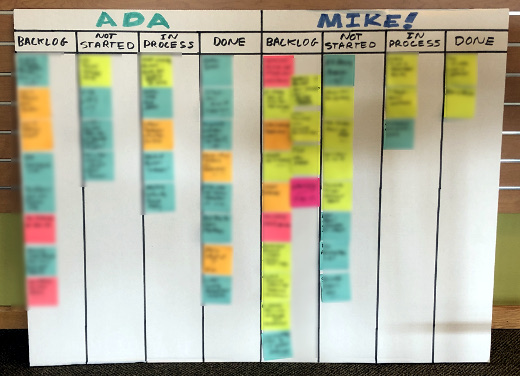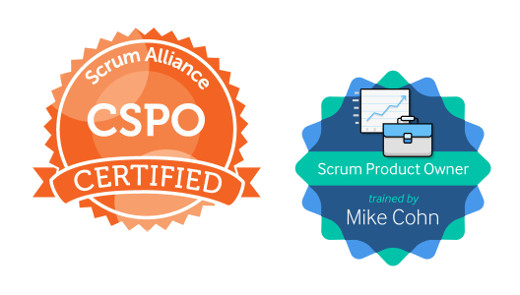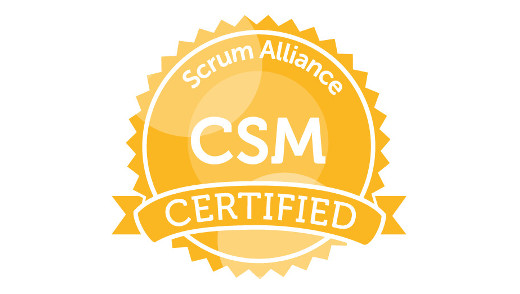Agile And Scrum Resources I Follow Right Now
Recently a colleague asked me what resources I follow in the Agile and Scrum space. As I have been in that universe for several years, some have come into my purview and later left, where others have remained. In the spirit of collaboration with her and the rest of the world, I share this list on my humble blog.
For these resources I have listed them with relevant links and noted some of the value I get from them and in what format. I have purposely listed them in reverse alphabetical order! In addition to these links, I follow many of these firms and individuals on LinkedIn.
Vitality Chicago – This is the firm run by Agile coach and consultant Anthony Mersino. He offers resources and training, and his blog and email list offer a wealth of information. I have taken several courses through my employer with him and his partners, as well as participated in several Agile Coffee sessions facilitated by him.
The Hot Iron – I will blow my own horn here and promote a link to the "Agile / Scrum" category on my own blog. Though I have only written a few posts, it helps me to digest what I learn and as well contribute to the Agile / Scrum universe.
Scrum.org – This is the organization started by Ken Schwaber, one of the co-creators of Scrum. They offer their own training programs and certification tracks, as well as resources including free webinars from a variety of coaches, all you can learn from their mailing list. I also subscribe to their blog which features a variety of writers on all aspects of Scrum.
Scrum Inc. – This is the firm run by Dr. Jeff Sutherland, the other co-creator of Scrum. They offer their own training programs and certification tracks, and resources including free webinars, which you can learn about from their mailing list. I also subscribe to their blog which covers a variety of topics and applications of Scrum beyond software.
Scrum Alliance – This is the original organization built around offering training and certification on Scrum. My Scrum Master and Scrum Product Owner certifications are through them, though they were taught by different independent coaches (both included on this list). They offer resources and webinars you can learn about on their mailing list. As my certifications are through them, I have access to a portal where I can take virtual courses to earn Scrum Education Units – similar to industry continuing education (CE) credits – which are required to renew your certification.
Scaled Agile Framework – Resource site on Scaled Agile, or SAFe. As I am still learning about what Scaled Agile and SAFe is, I can't speak much more to it, and much of what I have read is on their blog which I subscribe to.
Roman Pichler –Personal site for an Agile coach and consultant whose focus is on the Product Owner role and product management. I subscribe to his blog which is very insightful into the PO role, and his podcast is an oral version of what he writes.
Personal Agility – This site promotes the concept of using Agile in your personal life and has resources to guide you. You can subscribe to a daily email as a reminder for your own "personal standup" meeting.
Mountain Goat Software – Training and resources for firm run by Agile coach and consultant Mike Cohn. I took my Certified Scrum Product Owner certification course from. I subscribe to their blog feed and email newsletter. I also am a member of Agile Mentors, a great community forum with active participation and regular members-only events. A year's subscription came with my CSPO certification and charges a fee afterwards, and Mike himself is active in the forum. They have just launched a new podcast, the Agile Mentors Podcast. The photo above is of Planning Poker cards I got as a “thank you” for taking their CSPO course.
Richard Kasperowski – Personal site for an Agile coach and consultant. Much of what he covers are around the human aspects and interactions with people and Agile. I subscribe to his blog and he also has a podcast.
Incrementor –- Training and resources for firm run by Joe Krebs. I subscribe to their blog feed and email newsletter. They offer a variety of Agile posters and stickers, and the first order is free!
The Druckman Company – Training and resources for firm run by Angela Druckman. I subscribe to their blog feed and email newsletter.
Tom Cagley & Associates –This is the firm run by Tom Cagley, an Agile coach and consultant. I met him as he works with Anthony Mersino. His blog offers thoughtful writings and takeaways from re-reading of chapters in Agile and Scrum books.
agilityIRL – An Agile consulting firm where one of their partners, Mike Stuedemann, was the instructor when I took the Certified Scrum Master course that formally started me on my Agile journey. I subscribe to their very insightful blog as well as their email list.
Agile Alliance – Membership organization. I don't belong but I do subscribe to their blog feed and email newsletter. They host a variety of free and paid events.
This is from The Hot Iron, a journal on business and technology by Mike Maddaloni.
Did you enjoy this? Subscribe to The Hot Iron by RSS/XML feed or Read by Email
Agile / Scrum • (0) Comments • PermalinkMike Maddaloni Is A Certified Scrum Product Owner
Another timeout for a little self-promotion as I am proud to announce I am now a Certified Scrum Product Owner, or CSPO. A week ago I took a 2-day course and in the process gained certification through Scrum Alliance.
What is a CSPO?
A CSPO is a practitioner of the Scrum. With its origins in software development, Scrum is “framework within which people can address complex adaptive problems, while productively and creatively delivering products of the highest possible value.” A product owner is one of 3 roles on a Scrum team, along with the Scrum Master and Developers. The team delivers software, or whatever the work product is, in an iterative approach over periods of time called sprints, where a sprint can last a few weeks to a month. You can read more on Scrum in the Scrum Guide the “bible” on the framework.The role of the Product Owner is an empowered representative of the stakeholders for the product the entire Scrum team is working on. Its mission is to maximize the value of the product for said stakeholders and its users. High-level responsibilities include defining the Product Goal, managing the Product Backlog (or what the team will be working on), communicating and ensuring transparency.
Why the Product Owner Course? And didn’t you take the Scrum Master course?
Last year I took the course and exam to become a Certified ScrumMaster through Scrum Alliance. Through this process, I was really intrigued by the Product Owner role. In my current job, in many regards I serve as a Product Owner more than I do a Scrum Master. Also, I found a lot more emphasis on the Scrum Master role on the Scrum team “out there” more than I did on the Product Owner. This led me to pursue this course of study and serve in this capacity. Even had I not had this strong interest in being a Product Owner, I feel it important to understand all of the Scrum team roles to better serve as one of them.
The Course Itself
Before the global lockdowns last year, Scrum courses were never taught remotely. You would take a course near you or travel to take one in person. The Scrum Master course I took last year was virtual, though I had signed up for it as an in-person course originally. I was pleased with the last-minute pivot, the instructor and learned a lot from it.
All Scrum trainers have since gone to a virtual model. Where some courses are now starting to be taught in person, the majority are still online. This opened wide the possibilities from where to take the course. As I chose to continue courses through Scrum Alliance, I took the CSPO course through Mike Cohn, a veteran Scrum practitioner, trainer and author.Where I have only taken a few courses online over the years, this was by far the best offering I have experienced. The online “space” is integrated into Agile Mentors, a community and resource center whose membership is included for a year with the course. Before the live sessions, there was about 4 hours of “basics” videos going over the core of the Product Owner role, including quizzes throughout. It was structured this way to ensure to maximize the 2 days of live instruction, and it worked very well. I was equally impressed with the design of the overall experience – Cohn and his Mountain Goat Software spent a considerable amount of time in the branding and technology for this and all of their products.
No exam?
At the lunch break during the first day of the course it dawned on me there was no mention of an exam following the course to earn the certification. During the Q&A at the end of the day I asked this “meta” question. A good discussion followed and Cohn went into great detail on it from his own experience – he was a founder of the Scrum Alliance, and he said for this role it is a challenge to create questions for such an exam, as he has tried himself. Cohn’s upfront and no-nonsense approach was also a selling point for me on training with him. The non-binding quizzes throughout the pre-course videos did help in reinforcing the materials.
Without an exam and by actively participating in the course, this is the only qualification for the CSPO certification. Where I felt it was a little anticlimactic, I have decided it will be up to me to challenge myself as a Product Owner and always quiz myself. But what a better challenge for Scrum Alliance to develop an exam for this certification!
Next Steps and Kudos
I am looking forward to my continued journey with Scrum, the better way to do things – just ask Elon Musk! I have been asked my employer to help emphasize and further the Product Owner role, and I am up to the task. I also welcome your questions on Scrum in general. If you are thinking of studying for it as I did, I highly recommend the course from Mike Cohn. Thanks to him, Stacey Ackerman of the Agile Mentors community and the numerous classmates I had from around the area and the world who made the CSPO course a memorable experience.
This is from The Hot Iron, a journal on business and technology by Mike Maddaloni.
Did you enjoy this? Subscribe to The Hot Iron by RSS/XML feed or Read by Email
Announcements • Business • Agile / Scrum • Thrive • (0) Comments • PermalinkWhere To Continue My Scrum Training

With the New Year upon us, a lot of annual thoughts are swirling through my head, and one of them is regarding professional training. Last year I became a Certified ScrumMaster (CSM) through the Scrum Alliance. As I am thinking of what to take to continue my Scrum training, I am also thinking of where to take it, as the world of Scrum training changed in 2020.
In a departure from my typical posts of offering advice, this time I am seeking it. Please read on and I welcome your thoughts on my training journey.
That Was Then
My decision on the CSM course I did take was relatively straightforward. In discussion with colleagues I was advised the courses and certification from the Scrum Alliance were the most recognized. The other factor was location – I chose the closest course to me, and that was one being offered in Milwaukee, Wisconsin. I signed up for the April course in February, not knowing what was coming down the pike.
Shortly after the state shutdown order happened in Wisconsin, I got an email from the vendor offering the course that it would still be happening, and they would provide more details. As the date of course drew closer on the horizon, I was concerned with taking what could be a virtual course – no Scrum training to that point was offered online and was always in-person, and that was my preference. Several emails to the vendor went unanswered until I finally got a terse response – the course would be offered virtually, and as it was within the no-refund cancellation window I had no option to change it whatsoever. Cancellation windows were not a consideration when I signed up for it – I was going to take it no matter what, and that included driving the hour from home to the venue.
In the end, it was a great course. The instructor Mike Stuedemann of agilityIRL (a firm separate from the vendor) was very knowledgeable and ran a great virtual 2-day session. The class was composed mostly of people from Wisconsin, plus one from New York and another from Paris, France, which added nicely to the mix. I was well armed to take the certification exam, which I passed and gained the CSM title. Though my preference was still to take the course in a live setting, this was a perfect Plan B.
This is Now
Today most all Scrum training courses continue to be offered virtually. As well, my knowledge of the Scrum community has broadened since I became a member of it, and have learned of other organizations offering the courses, all virtually. Needless to say this opens up a whole potential for taking courses, including ones from Scrum Inc. taught by none other than Dr. Jeff Sutherland, the co-creator of Scrum.
How to Proceed?
With all of these opportunities, I am curious how to proceed. Should I continue taking courses through Scrum Alliance? I have no issues per se with the training I received or the organization as a whole. Or should I look to other organizations that offer the training, like Sutherland’s Scrum Inc. or Scrum.org, a firm led by Ken Schwaber, the other co-creator of Scrum? There are also other firms offering courses and certifications as well.
Does continuing with one firm make more sense? Is looking to other firms a good or bad thing? Are there approaches to the instruction of one better than the other, overall or course-by-course?
The answers to these questions I don’t have, and I am putting this out to the greater community for advice. Where I have seen comparisons of various firms and their courses, I am also interested in the experience of people who have first-hand knowledge.
I welcome your thoughts here in the comments of this blog post, and I thank you in advance.
This is from The Hot Iron, a journal on business and technology by Mike Maddaloni.
Did you enjoy this? Subscribe to The Hot Iron by RSS/XML feed or Read by Email
Agile / Scrum • Technology • (0) Comments • PermalinkMy Personal Scrum Boards

Shortly after completing my Scrum training and becoming a Certified ScrumMaster, it was clear to me that in order to be successful at the Agile framework, I have to be an active practitioner. Where I am planning that in my job with my director who is a Scrum Master himself, I sought other ways to use it.
Where I am applying Scrum right away is in my own work and in my personal life. The latter was reinforced when I read Scrum: The Art of Doing Twice the Work in Half the Time by Jeff Sutherland as he talks about how to use Scrum well beyond software development. This led me to creating personal Scrum Boards for both. The picture accompanying this post is of my Scrum Boards, with my work one to the left and my personal one to the right.
Elements of a Scrum Board
A Scrum Board is a tool for tracking progress and providing visibility on a project. There is single definition of how one is structured or organized, as it should ideally fit your needs, whether individually or for your Scrum Team. The basic components of it should include the following, and I also indicate how I have adapted these components for my needs.
Backlog – A Backlog is the work to be done. Larger, higher-level items are called Epics, and smaller, shorter, more specific items are called User Stories.
In both of my Scrum Boards the Backlog is the first column – yes, I purposely blurred out the tasks in it, both for confidentiality and to not bore you, my dear reader, of the mundane minutiae of my life. Most all of these are User Stories. Each is written on a Post-It note so they can be easily moved around.
Not Started – This is actually an optional component, and is also referred to as a Sprint Backlog. All work done in Scrum is done in Sprints, a defined period of time such as 2 or 4 weeks. The items in these columns are what I plan to work on during the week. As it is not required, I simply could have all of my Backlog prioritized in one column.
For myself, I have 1-week Sprints. At the start of the week, I review – or Refine – the Backlog and select the work to be done in the Sprint. Refinement also includes readdressing the priorities of Epics and User Stories, which can vary from week to week, or in this case Sprint to Sprint. Once this process is completed, I move the Post-Its to the appropriate column.
In Process – When I start an Epic or User Story, I move it to this column from Not Started, indicating what I am actively working on.
It’s not uncommon for me to have multiple items in process as I am often awaiting something else to be completed to proceed. It is not my intent to have more things in process than I can manage. The goal here is to use this to get more work done by breaking tasks into smaller components.
Done – Once a User Story or Epic has been completed, it gets moved to this column, and a small celebration takes place in my mind.
The accompanying photo was taken towards the end of last week, when I had several items done, and since then I completed more. At the end of the week I clear all Done items, and hold a review, or Retrospective, to go over the week, realities in my schedule, setting up the next Sprint the following week.
More To It Beyond Myself
In using Sprint Boards for personal work, I am adapting it from a standard Scrum flow. I am performing the roles of a Scrum Team myself – the Scrum Master, Product Owner and Development Team. I also am not doing a Sprint Review per se, a process of demonstrating the work of a sprint for approval, for as I move an item to Done I am reviewing it at that time. Additionally, my Retrospective and Refinement processes are not as involved.
A Scrum Board is typically displayed prominently in an office or managed using an online tool that all have access to. Mine is on a project board that kids use at school for presentations, as its tri-fold format allows me to easily transport it through my house or even to my co-working space. During the workday it is open and visible and at night it’s folded away.
There are other components that can be added to a Scrum Board. This article from Scrum Inc. on Scrum Boards expands more on them, and how other elements of Scrum interface with them.
You Can Do It
Have I convinced you to have your own Scrum Board? I welcome your thoughts and how you manage your own in the comments to this post.
Deconstructing Scrum Boards
A single, visible place for all elements of your project are what Scrum Boards are for and are a key component to the Scrum framework. Though my own Scrum Boards are modified in some form to use for myself, even in this form it is good practice to follow as my overall work is transformed towards Agile.
This is from The Hot Iron, a journal on business and technology by Mike Maddaloni.
Did you enjoy this? Subscribe to The Hot Iron by RSS/XML feed or Read by Email
Business • Agile / Scrum • Thrive • (4) Comments • PermalinkMike Maddaloni is a Certified ScrumMaster
A timeout for a little self-promotion as I am proud to announce I am now a Certified ScrumMaster® or CSM. Last week I took a 2-day course and over the weekend I passed the exam from the Scrum Alliance to become a CSM.
What is a CSM?
A CSM is a practitioner of the Scrum. With its origins in software development, Scrum is “framework within which people can address complex adaptive problems, while productively and creatively delivering products of the highest possible value.” The Scrum Master facilitates the Scrum and is one of 3 roles on a Scrum team. The team delivers software, or whatever the work product is, in an iterative approach over periods of time called sprints, where a sprint can last a few weeks to a month.
There is much more to Scrum, and I will be writing more about it in the future. A good guide to Scrum is called simply The Scrum Guide by the co-creators of Scrum, Jeff Sutherland and Ken Schwaber, and you can read it at ScrumGuides.org. The definition of Scrum quoted above comes from The Scrum Guide. Among the myriad of books out there on Scrum is Scrum: The Art of Doing Twice the Work in Half the Time by Sutherland that I previously read and wrote takeaways about.
Now what?
One thing that was clear to me from the course is that Scrum is a framework you must actively participate in to gain your expertise. I will be taking a two-prong approach to this. For my job, I will be discussing Scrum with leadership. As well, I will be using Scrum in my personal life to manage my multiple activities and projects.
Just the Beginning
I am excited for this certification. The course and test were a tremendous learning opportunity, and I look forward to continued learning to maintain the certification. Of course more importantly is applying what I learned and honing my skills in Scrum. Special thanks to my instructor Mike Stuedemann and my classmates Ibrahim, Nelia, Nicole and Rod for a fun and engaging learning experience.
Certified ScrumMaster® is a certification mark of Scrum Alliance, Inc. Any unauthorized use is strictly prohibited.
This is from The Hot Iron, a journal on business and technology by Mike Maddaloni.
Did you enjoy this? Subscribe to The Hot Iron by RSS/XML feed or Read by Email
Announcements • Agile / Scrum • Thrive • Web Development • (0) Comments • Permalink



